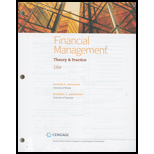
Shrieves Casting Company is considering adding a new line to its product mix, and the capital budgeting analysis is being conducted by Sidney Johnson, a recently graduated MBA. The production line would be set up in unused space in the main plant. The machinery’s invoice price would be approximately $200,000, another $10,000 in shipping charges would be required, and it would cost an additional $30,000 to install the equipment. The machinery has an economic life of 4 years, and Shrieves has obtained a special tax ruling that places the equipment in the MACRS 3-year class. The machinery is expected to have a salvage value of $25,000 after 4 years of use.
The new line would generate incremental sales of 1,000 units per year for 4 years at an incremental cost of $100 per unit in the first year, excluding depreciation. Each unit can be sold for $200 in the first year. The sales price and cost are both expected to increase by 3% per year due to inflation. Further, to handle the new line, the firm’s net working capital would have to increase by an amount equal to 12% of sales revenues. The firm’s tax rate is 25%, and its overall weighted average cost of capital, which is the risk-adjusted cost of capital for an average project (r), is 10%.
Define “incremental cash flow.”
- (1) Should you subtract interest expense or dividends when calculating project cash flow?
- (2) Suppose the firm spent $100,000 last year to rehabilitate the production line site. Should this be included in the analysis? Explain.
- (3) Now assume the plant space could be leased out to another firm at $25,000 per year. Should this be included in the analysis? If so, how?
- (4) Finally, assume that the new product line is expected to decrease sales of the firm’s other lines by $50,000 per year. Should this be considered in the analysis? If so, how?
Trending nowThis is a popular solution!

Chapter 11 Solutions
FINANCIAL MANAGEMENT(LL)-TEXT
- 3-7. (Working with an income statement and balance sheet) Prepare a balance sheet and income statement for Kronlokken Company from the following scrambled list of items. a. Prepare a common-sized income statement and a common-sized balance sheet. Interpret your findings. Depreciation expense $66,000 Cash 225,000 Long-term debt 334,000 Sales 573,000 Accounts payable 102,000 General and administrative expense 79,000 Buildings and equipment 895,000 Notes payable 75,000 Accounts receivable 153,000 Interest expense 4,750 Accrued expenses 7,900 Common stock 289,000 Cost of goods sold 297,000 Inventory 99,300 Taxes 50,500 Accumulated depreciation 263,000 Prepaid expenses 14,500 Taxes payable 53,000 Retained earnings 262,900 ||arrow_forwardx3-3. (Preparing an income statement) Prepare an income statement and a common- sized income statement from the following information. MyLab Sales Cost of goods sold General and administrative expenses Depreciation expenses Interest expense Income taxes $525,000 200,000 62,000 8,000 12,000 97,200arrow_forward3-9. (Working with a statement of cash flows) Given the following information, prepare LO3 a statement of cash flows. Increase in accounts receivable Increase in inventories Operating income Interest expense Increase in accounts payable Dividends $25 30 75 25 25 15 20 Increase in net fixed assets 23 Depreciation expense Income taxes 12 17 Beginning cash 20 Increase in common stockarrow_forward
- 3-4. (Preparing a balance sheet) Prepare a balance sheet from the following informa- LO2 tion. What is the net working capital and debt ratio? Cash $50,000 Account receivables 42,700 Accounts payable 23,000 Short-term notes payable 10,500 Inventories 40,000 Gross fixed assets 1,280,000 Other current assets 5,000 Long-term debt 200,000 Common stock 490,000 Other assets 15,000 Accumulated depreciation 312,000 Retained earnings ? MyLabarrow_forwardPlease help with questions.arrow_forwardWhat is the research design? How does it work? What are the differences between Research design and Case Study research?arrow_forward
- How to judge the quality of research designs? Could you help explain and give examples?arrow_forwardConsider a situation involving determining right and wrong. Do you believe utilitarianism provides a more objective viewpoint than moral rights in this context? Why or why not? How about when comparing utilitarianism to principles of justice? Share your thoughts. Reflect on this statement: "Every principle of distributive justice, whether that of the egalitarian, the capitalist, the socialist, the libertarian, or Rawls, in the end is illegitimately advocating some type of equality." Do you agree or disagree with this assertion? Why might someone claim this, and how would you respond?arrow_forwardI need help checking my spreadsheet. Q: Assume that Temp Force’s dividend is expected to experience supernormal growth of 73%from Year 0 to Year 1, 47% from Year 1 to Year 2, 32% from Year 2 to Year 3 and 21% from year3 to year 4. After Year 4, dividends will grow at a constant rate of 2.75%. What is the stock’sintrinsic value under these conditions? What are the expected dividend yield and capital gainsyield during the first year? What are the expected dividend yield and capital gains yield duringthe fifth year (from Year 4 to Year 5)?arrow_forward
- what are the five components of case study design? Please help explain with examplesarrow_forwardCommissions are usually charged when a right is exercised. a warrant is exercised. a right is sold. all of the above will have commissions A and B are correct, C is not correctarrow_forwardWhat is Exploratory Research Case Study? What is the main purpose of Exploratory Research?arrow_forward
 Intermediate Financial Management (MindTap Course...FinanceISBN:9781337395083Author:Eugene F. Brigham, Phillip R. DavesPublisher:Cengage Learning
Intermediate Financial Management (MindTap Course...FinanceISBN:9781337395083Author:Eugene F. Brigham, Phillip R. DavesPublisher:Cengage Learning
 EBK CONTEMPORARY FINANCIAL MANAGEMENTFinanceISBN:9781337514835Author:MOYERPublisher:CENGAGE LEARNING - CONSIGNMENT
EBK CONTEMPORARY FINANCIAL MANAGEMENTFinanceISBN:9781337514835Author:MOYERPublisher:CENGAGE LEARNING - CONSIGNMENT Cornerstones of Cost Management (Cornerstones Ser...AccountingISBN:9781305970663Author:Don R. Hansen, Maryanne M. MowenPublisher:Cengage Learning
Cornerstones of Cost Management (Cornerstones Ser...AccountingISBN:9781305970663Author:Don R. Hansen, Maryanne M. MowenPublisher:Cengage Learning Managerial AccountingAccountingISBN:9781337912020Author:Carl Warren, Ph.d. Cma William B. TaylerPublisher:South-Western College Pub
Managerial AccountingAccountingISBN:9781337912020Author:Carl Warren, Ph.d. Cma William B. TaylerPublisher:South-Western College Pub





